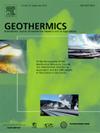Optimizing inhibitor injection in geothermal wells with electrical submersible pump
IF 3.5
2区 工程技术
Q3 ENERGY & FUELS
引用次数: 0
Abstract
Electrical submersible pump (ESP) is a reliable artificial lift method to extend productive lifespan of geothermal wells. In the geothermal industry a common practice involves installing ESPs below the well's flashing depth. This placement approach aims to mitigate the risk of mineral precipitation, which can occur when hot geothermal fluids transition to a two-phase state (liquid and vapor) as pressure decreases. Positioning the pump below the flashing depth also prevents pump's underloading and gas cavitation. The inhibitor injection line usually integrated around the ESP string and installed downstream of the ESP motor. However, this standard practice introduces a challenge regarding inhibitor performance. While this placement ensures effective distribution of inhibitors throughout the production flow, the extended travel time from the surface to the point of application at the ESP can diminish inhibitor effectiveness due to continuous exposure to high temperatures throughout the wellbore. This study proposes relocating the inhibitor injection point within the production tubing closer to the flashing depth. This reduces inhibitor travel time from 108 min to 48 min and has the potential to significantly improve inhibitor effectiveness. Consequently, the implementation of capillary tubing is anticipated to yield annual cost savings per wellbore of approximately USD 10,000, coupled with the mitigation of mineral deposits within the studied well equipped with ESP. To evaluate this approach, a wellbore simulation tool and PHREEQC were employed to dynamically model the pressure and temperature profiles alongside the geochemical evolution of the produced fluids in the wellbore. This modeling approach offers significant value by potentially enabling the optimization of inhibitor usage and reducing the length of required inhibitor injection line.
利用电潜泵优化地热井抑制剂注入
电潜泵是延长地热井生产寿命的一种可靠的人工举升方法。在地热行业,一个常见的做法是将esp安装在井的闪光深度以下。这种放置方法旨在降低矿物沉淀的风险,当热地热流体随着压力降低而转变为两相状态(液体和蒸汽)时,可能会发生矿物质沉淀。将泵定位在闪光深度以下,还可以防止泵的欠载和气体空化。缓蚀剂注入管线通常集成在ESP管柱周围,安装在ESP马达的下游。然而,这种标准做法带来了抑制剂性能方面的挑战。虽然这种布置确保了抑制剂在整个生产流程中的有效分布,但由于整个井筒持续暴露在高温下,从地面到ESP应用点的行程时间延长,可能会降低抑制剂的有效性。该研究建议将生产油管内的抑制剂注入点重新定位到更靠近闪光深度的位置。这将缓蚀剂的运行时间从108分钟减少到48分钟,并有可能显著提高缓蚀剂的有效性。因此,预计采用毛细管技术每井每年可节省约10,000美元的成本,同时还可减少ESP所研究井内的矿物沉积。为了评估这种方法,研究人员使用了井筒模拟工具和PHREEQC,对井筒中产出流体的压力和温度曲线以及地球化学演化进行动态建模。这种建模方法具有重要的价值,可以优化抑制剂的使用,缩短所需抑制剂注入管线的长度。
本文章由计算机程序翻译,如有差异,请以英文原文为准。
求助全文
约1分钟内获得全文
求助全文
来源期刊

Geothermics
工程技术-地球科学综合
CiteScore
7.70
自引率
15.40%
发文量
237
审稿时长
4.5 months
期刊介绍:
Geothermics is an international journal devoted to the research and development of geothermal energy. The International Board of Editors of Geothermics, which comprises specialists in the various aspects of geothermal resources, exploration and development, guarantees the balanced, comprehensive view of scientific and technological developments in this promising energy field.
It promulgates the state of the art and science of geothermal energy, its exploration and exploitation through a regular exchange of information from all parts of the world. The journal publishes articles dealing with the theory, exploration techniques and all aspects of the utilization of geothermal resources. Geothermics serves as the scientific house, or exchange medium, through which the growing community of geothermal specialists can provide and receive information.
 求助内容:
求助内容: 应助结果提醒方式:
应助结果提醒方式:


